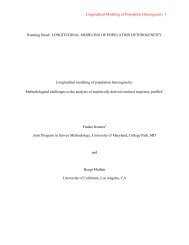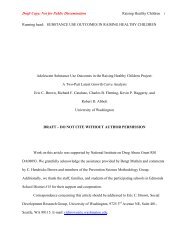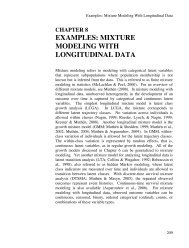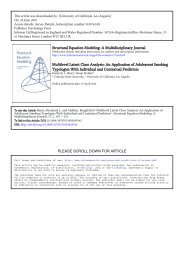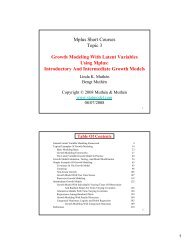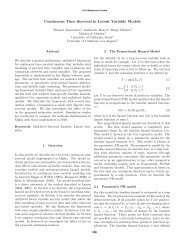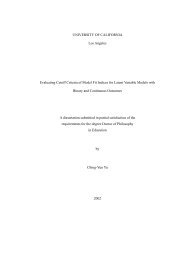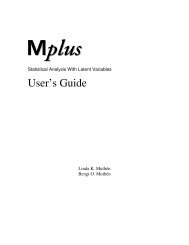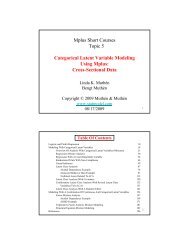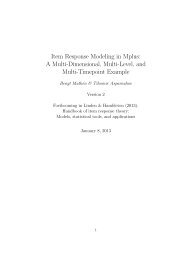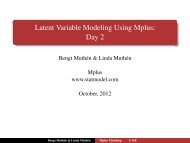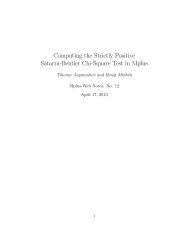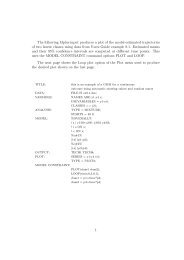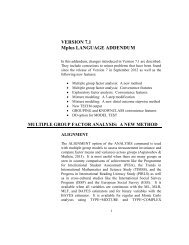IRT in Mplus
IRT in Mplus
IRT in Mplus
Create successful ePaper yourself
Turn your PDF publications into a flip-book with our unique Google optimized e-Paper software.
<strong>IRT</strong> <strong>in</strong> <strong>Mplus</strong><br />
August 4, 2006<br />
In this note we describe several of the <strong>IRT</strong> model<strong>in</strong>g features implemented<br />
<strong>in</strong> <strong>Mplus</strong>, namely the the item characteristic curves, the item <strong>in</strong>formation<br />
curves, the total <strong>in</strong>formation curve, item difficulty parameter and item discrim<strong>in</strong>ation<br />
parameter.<br />
1 ICC curves<br />
1.1 Logit L<strong>in</strong>k, ML/MLR/MLF Estimators<br />
Let U i be a categorical <strong>in</strong>dicator for a latent factor f <strong>in</strong> the presence of a<br />
categorical latent class variable C. The item characteristic curves (ICC) for<br />
the item U i , given that C = k are computed as follows us<strong>in</strong>g the logistic<br />
model. If the category j is the first category<br />
P ijk (f) = P (U i = j|f, C = k) =<br />
If the category j is the last category<br />
P ijk (f) = P (U i = j|f, C = k) = 1 −<br />
If the category j is a middle category<br />
P ijk (f) = P (U i = j|f, C = k) =<br />
1<br />
1 + Exp(−τ ijk + λ ik f) . (1)<br />
1<br />
1 + Exp(−τ ij−1k + λ ik f) . (2)<br />
1<br />
1 + Exp(−τ ijk + λ ik f) − 1<br />
1 + Exp(−τ ij−1k + λ ik f) . (3)<br />
1
In the presence of other covariates/other latent variables X the formulas are<br />
modified as follows. If the category j is the first category<br />
P ijk (f) = P (U i = j|f, C = k, X = x) =<br />
If the category j is the last category<br />
P ijk (f) = P (U i = j|f, C = k, X = x) =<br />
1 −<br />
If the category j is a middle category<br />
1<br />
1 + Exp(−τ ijk + λ ik f + β ik x) . (4)<br />
1<br />
1 + Exp(−τ ij−1k + λ ik f + β ik x) . (5)<br />
P ijk (f) = P (U i = j|f, C = k, X = x) =<br />
1<br />
1 + Exp(−τ ijk + λ ik f + β ik x) − 1<br />
1 + Exp(−τ ij−1k + λ ik f + β ik x) . (6)<br />
1.2 Probit L<strong>in</strong>k, ML/MLR/MLF Estimators<br />
Let Φ be the standard normal cumulative distribution function. The ICC<br />
curves are given as follows. If the category j is the first category<br />
P ijk (f) = P (U i = j|f, C = k, X = x) = Φ(τ ijk − λ ik f − β ik x). (7)<br />
If the category j is the last category<br />
P ijk (f) = P (U i = j|f, C = k, X = x) =<br />
If the category j is a middle category<br />
1 − Φ(τ ij−1k − λ ik f − β ik x). (8)<br />
P ijk (f) = P (U i = j|f, C = k, X = x) =<br />
Φ(τ ijk − λ ik f − β ik x) − Φ(τ ij−1k − λ ik f − β ik x). (9)<br />
2
1.3 Probit L<strong>in</strong>k, WLS/WLSM/WLSMV/ULS Estimators,<br />
Theta Parametrization<br />
In this situation the model does not <strong>in</strong>clude latent categorical variable C<br />
however multiple group models are <strong>in</strong>cluded. Let G denote the group variable.<br />
With the Theta parametrization the residual parameter θ ik is an actual<br />
parameter <strong>in</strong> the model. For basic models this parameter is fixed to 1 s<strong>in</strong>ce it<br />
will not be identified without model restrictions, however for multiple group<br />
and growth models the parameter could be identified. If these parameters<br />
are not pr<strong>in</strong>ted <strong>in</strong> the results section that means that they are fixed to 1.<br />
The ICC curves are given as follows. If the category j is the first category<br />
(<br />
τijk − λ ik f − β ik x<br />
P ijk (f) = P (U i = j|f, G = k, X = x) = Φ √<br />
). (10)<br />
θik<br />
If the category j is the last category<br />
P ijk (f) = P (U i = j|f, G = k, X = x) =<br />
(<br />
τij−1k − λ ik f − β ik x<br />
1 − Φ √<br />
). (11)<br />
θik<br />
If the category j is a middle category<br />
P ijk (f) = P (U i = j|f, G = k, X = x) =<br />
( ) (<br />
τijk − λ ik f − β ik x τij−1k − λ<br />
Φ √ ik f − β ik x<br />
− Φ √<br />
). (12)<br />
θik θik<br />
1.4 Probit L<strong>in</strong>k, WLS/WLSM/WLSMV/ULS Estimators,<br />
Delta Parametrization<br />
With the Delta parametrization the θ ik are not actual parameters but are<br />
dependent parameters that are obta<strong>in</strong>ed from the follow<strong>in</strong>g equation<br />
θ ik = ∆ −2<br />
ik<br />
− V ar(λ ikf)<br />
where ∆ ik are actual parameters that can be either free or fixed. Aga<strong>in</strong><br />
the ∆ ik are typically not identifiable and are fixed to 1, however <strong>in</strong> growth<br />
and multiple group models the parameter can be free and identified. When<br />
the ∆ ik parameters are not present <strong>in</strong> the results, they are fixed to 1. The<br />
θ ik parameters are always reported <strong>in</strong> the results section and are typically<br />
smaller than 1. For example when the ∆ ik parameters are fixed to 1 the θ ik<br />
are smaller than 1. The ICC curves are given as <strong>in</strong> the previous section.<br />
3
2 IIC curves<br />
The item <strong>in</strong>formation curves (IIC) for a categorical <strong>in</strong>dicator U i and a latent<br />
factor f <strong>in</strong> class C = k is computed as follows. Let y ijk be the sample<br />
frequency for category j <strong>in</strong> class k. In comput<strong>in</strong>g these frequencies we use the<br />
posterior class distribution for each observation to allocate each observation<br />
partially with<strong>in</strong> each of the possible classes. When there is only one class<br />
these sample frequencies are the observed sample frequencies. Def<strong>in</strong>e the<br />
cumulative sample frequencies as x ijk = ∑ j<br />
r=1 y irk . If the total number of<br />
categories for U i are l then x i0k = 0 and x ilk = 1. Also def<strong>in</strong>e for 1 ≤ j ≤ l−1<br />
j∑<br />
Q ijk = P irk . (13)<br />
r=1<br />
The IIC is the likelihood <strong>in</strong>formation function (second derivative with respect<br />
to f). For the ML/MLF/MLR estimators with the probit or logit l<strong>in</strong>k<br />
functions the IIC curve is given by<br />
I i (f) = λ 2 ik<br />
∑l−1<br />
j=1<br />
(x ij+1k − x ij−1k )Q ijk (1 − Q ijk ). (14)<br />
For the WLS/WLSM/WLSMV/ULS estimators with the probit l<strong>in</strong>k functions<br />
and either theta or delta parametrization the IIC curve is given by<br />
I i (f) = λ2 ∑<br />
ik<br />
(x ij+1k − x ij−1k )Q ijk (1 − Q ijk ). (15)<br />
θ ik<br />
l−1<br />
j=1<br />
The total <strong>in</strong>formation function is obta<strong>in</strong>ed by add<strong>in</strong>g all item <strong>in</strong>formation<br />
functions<br />
I(f) = ∑ I i (f). (16)<br />
i<br />
3 <strong>IRT</strong> Parameterization<br />
For b<strong>in</strong>ary items with a s<strong>in</strong>gle factor we provide the parameter estimates also<br />
<strong>in</strong> the traditional <strong>IRT</strong> scale. Let the factor mean be α and the factor variance<br />
be ψ. Thus f = α + √ ψθ where θ is the <strong>IRT</strong> standard normal latent variable<br />
4
with mean 0 and standard deviation 1. For the ML/MLF/MLR estimators<br />
with the logit l<strong>in</strong>k function<br />
P (U i = 1|f) =<br />
1<br />
1 + Exp(τ ik − λ ik f) = 1<br />
1 + Exp(−Da ik (θ − b ik ))<br />
(17)<br />
where D = 1.7 is a constant that gives the <strong>IRT</strong> estimates close to the probit<br />
scale, a ik is the item discrim<strong>in</strong>ation parameter and b ik is the item difficulty<br />
parameter. These parameters are computed as follows<br />
a ik = λ √<br />
ik ψ<br />
(18)<br />
D<br />
b ik = τ ik − λ ik α<br />
λ ik<br />
√ ψ<br />
. (19)<br />
For the other estimations, l<strong>in</strong>ks and parametrization the <strong>IRT</strong> parametrization<br />
is obta<strong>in</strong>ed by the same approach. The result<strong>in</strong>g formulas for b ik is<br />
the same as (19), while the parameter a ik is obta<strong>in</strong>ed as follows. For the<br />
ML/MLF/MLR estimators with the probit l<strong>in</strong>k function<br />
a ik = λ ik<br />
√ψ. (20)<br />
For the WLS/WLSM/WLSMV/ULS estimators with the probit l<strong>in</strong>k functions<br />
and theta parametrization<br />
a ik = λ √<br />
ik ψ<br />
√ (21)<br />
θik<br />
For the WLS/WLSM/WLSMV/ULS estimators with the probit l<strong>in</strong>k functions<br />
and delta parametrization<br />
a ik =<br />
1<br />
√<br />
∆ −2<br />
ik λ−2 ik ψ−1 − 1<br />
(22)<br />
The standard errors of these parameters are computed by the delta method.<br />
4 References<br />
The follow<strong>in</strong>g references can be used for additional <strong>in</strong>formation on the <strong>IRT</strong><br />
model.<br />
5
Baker, F.B. & Kim, S.H. (2004). Item response theory. Parameter estimation<br />
techniques. Second edition. New York: Marcel Dekker.<br />
Bock, R.D. (1997). A brief history of item response theory. Educational<br />
Measurement: Issues and Practice, 16, 21-33.<br />
du Toit, M. (2003). <strong>IRT</strong> from SSI. L<strong>in</strong>colnwood, IL: Scientific Software<br />
International, Inc. (BILOG, MULTILOG, PARSCALE, TESTFACT)<br />
Embretson, S. E., & Reise, S. P. (2000). Item response theory for psychologists.<br />
Mahwah, NJ: Erlbaum.<br />
Hambleton, R.K. & Swam<strong>in</strong>athan, H. (1985).<br />
Boston: Kluwer-Nijhoff.<br />
Item response theory.<br />
MacIntosh, R. & Hashim, S. (2003). Variance estimation for convert<strong>in</strong>g<br />
MIMIC model parameters to <strong>IRT</strong> parameters <strong>in</strong> DIF analysis. Applied Psychological<br />
Measurement, 27, 372-379.<br />
Muthen, B. (1985). A method for study<strong>in</strong>g the homogeneity of test items<br />
with respect to other relevant variables. Journal of Educational Statistics,<br />
10, 121-132. (#13)<br />
Muthen, B. (1988). Some uses of structural equation model<strong>in</strong>g <strong>in</strong> validity<br />
studies: Extend<strong>in</strong>g <strong>IRT</strong> to external variables. In H. Wa<strong>in</strong>er & H.<br />
Braun (Eds.), Test Validity (pp. 213-238). Hillsdale, NJ: Erlbaum Associates.<br />
(#18)<br />
Muthen, B. (1989). Us<strong>in</strong>g item-specific <strong>in</strong>structional <strong>in</strong>formation <strong>in</strong> achievement<br />
model<strong>in</strong>g. Psychometrika, 54, 385-396. (#30)<br />
Muthen, B. (1994). Instructionally sensitive psychometrics: Applications<br />
to the Second International Mathematics Study. In I. Westbury, C. Eth<strong>in</strong>gton,<br />
L. Sosniak & D. Baker (Eds.), In search of more effective mathematics<br />
education: Exam<strong>in</strong><strong>in</strong>g data from the IEA second <strong>in</strong>ternational mathematics<br />
study (pp. 293-324). Norwood, NJ: Ablex. (#54)<br />
Muthen, B. & Asparouhov, T. (2002). Latent variable analysis with cat-<br />
6
egorical outcomes: Multiple-group and growth model<strong>in</strong>g <strong>in</strong> <strong>Mplus</strong>. <strong>Mplus</strong><br />
Web Note #4 ( www.statmodel.com).<br />
Muthen, B., Kao, Chih-Fen & Burste<strong>in</strong>, L. (1991). Instructional sensitivity<br />
<strong>in</strong> mathematics achievement test items: Applications of a new <strong>IRT</strong>-based<br />
detection technique. Journal of Educational Measurement, 28, 1-22. (#35)<br />
Muthen, B. & Lehman, J. (1985). Multiple-group <strong>IRT</strong> model<strong>in</strong>g: Applications<br />
to item bias analysis. Journal of Educational Statistics, 10, 133-142.<br />
(#15)<br />
Samejima, F. (1972) A general model for free-response data. Psychometrika<br />
Monograph Supplement, No.18<br />
Takane, Y. & DeLeeuw, J. (1987). On the relationship between item<br />
response theory and factor analysis of discretized variables. Psychometrika,<br />
52, 393-408.<br />
7



